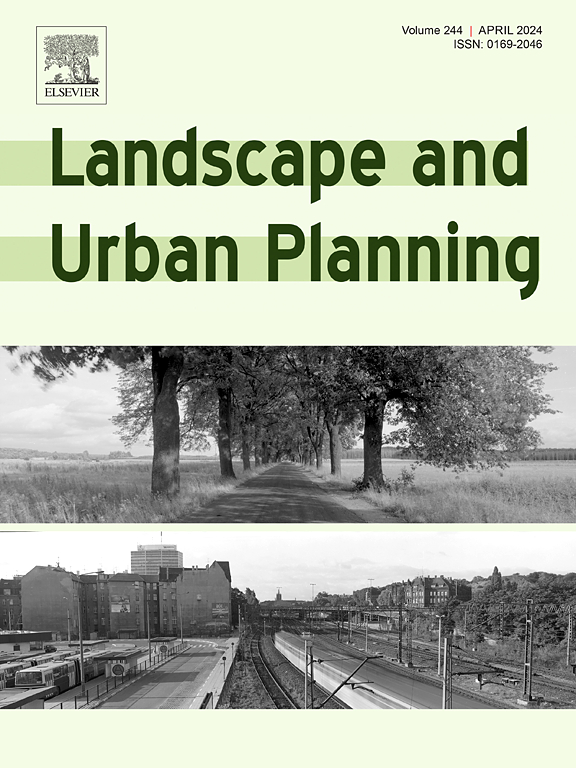设计未来的生物多样性友好型城市:鸟类群落对土地共享和土地节约的看法
IF 9.2
1区 环境科学与生态学
Q1 ECOLOGY
引用次数: 0
摘要
全球城市人口的持续增长将对生物多样性和生态系统服务产生深远的压力。城市规划者面临着既要适应这种增长,又要尽量减少其对生物多样性的影响的挑战。这可以通过城市土地节约(开发目前低密度的城市地区,而不扩展到邻近的半自然栖息地)或土地共享(创建相对低密度的地区,以取代半自然栖息地)来实现。我们通过研究城市繁殖鸟类多样性和相关生态系统服务(鸟类审美吸引力)和危害(容易产生人类与野生动物冲突的物种的发生)对意大利六个城市人口密度梯度的响应,评估了这两种策略的支持度。随着人口密度的增加,鸟类的分类和功能多样性下降,鸟类介导的生态系统服务功能减少,但鸟类生物量增加,与鸟类相关的生态系统服务功能减少。森林物种和洞巢巢支持土地节约。其他关系是线性的,不支持任何一种策略。为了增加鸟类多样性和相关的生态系统服务,我们建议在已经城市化的地区增加人口密度,同时通过保护半自然栖息地来保护现有的鸟类多样性,特别是在城市边缘。其中,森林和城市绿地显著提高了鸟类多样性,而城郊农田则简化了鸟类多样性。为了设计更多的鸟类友好型城市,我们建议:1)提高现有城市森林遗迹的质量;2)优先考虑城乡结合部农田的城市再造林;3)扩大城市绿色基础设施,以支持与森林相关的鸟类多样性,并降低人口密集城市的社会成本。本文章由计算机程序翻译,如有差异,请以英文原文为准。
Designing the biodiversity-friendly city of the future: An avian community perspective on land sharing and land sparing
The continuing increase in the global urban human population will exert profound pressures on biodiversity and ecosystem services. Urban planners face the challenge of accommodating such growth while minimising its impact on biodiversity. This could be achieved through urban land sparing (developing currently low density urban areas without expanding into adjacent semi-natural habitats) or land sharing (creating relatively low density areas in place of semi-natural habitats). We assessed support for these two strategies by examining how urban breeding bird diversity and associated ecosystem services (bird aesthetic attractiveness) and disservices (occurrence of species prone to generate human-wildlife conflicts) responded to a gradient of human population density measured across six Italian cities. As human population density increased, there was a decline in avian taxonomic and functional diversity and a bird-mediated ecosystem service, but an increase in bird biomass and a bird-related ecosystem disservice. Land sparing was supported in forest species and cavity nesters. Other relationships were linear, with no support for either strategy. To enhance bird diversity and related ecosystem services in our study region, we recommend increasing human population densities within already urbanised areas, while conserving existing bird diversity by preserving semi-natural habitats, particularly at the urban fringe. Among these, forest and urban green spaces significantly enhanced bird diversity, in contrast to the simplified assemblages in peri-urban farmlands. To design more bird-friendly cities, we recommend to: 1) improve the quality of existing urban forest remnants, 2) prioritise urban reforestation on farmland at the urban–rural fringe, and 3) expand urban green infrastructures to support forest-associated bird-diversity and to reduce social costs of densely populated cities.
求助全文
通过发布文献求助,成功后即可免费获取论文全文。
去求助
来源期刊

Landscape and Urban Planning
环境科学-生态学
CiteScore
15.20
自引率
6.60%
发文量
232
审稿时长
6 months
期刊介绍:
Landscape and Urban Planning is an international journal that aims to enhance our understanding of landscapes and promote sustainable solutions for landscape change. The journal focuses on landscapes as complex social-ecological systems that encompass various spatial and temporal dimensions. These landscapes possess aesthetic, natural, and cultural qualities that are valued by individuals in different ways, leading to actions that alter the landscape. With increasing urbanization and the need for ecological and cultural sensitivity at various scales, a multidisciplinary approach is necessary to comprehend and align social and ecological values for landscape sustainability. The journal believes that combining landscape science with planning and design can yield positive outcomes for both people and nature.
 求助内容:
求助内容: 应助结果提醒方式:
应助结果提醒方式:


